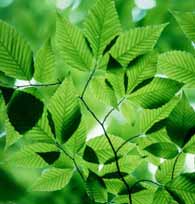This is the VOA Special English Agriculture Report.
Scientists have discovered more details about how plants use water. Their findings could help to engineer plants that grow better and more effectively in conditions with higher levels of carbon dioxide.
Plants naturally take in carbon dioxide they need for photosynthesis, the process of changing light energy to chemical energy. The carbon dioxide enters the plants through tiny holes or pores on the surface of leaves.

However, each time a plant takes in one molecule of carbon dioxide gas, it loses hundreds of water molecules.
Scientists say plants lose 95 percent of the water they take in through these pores. Some plants' pores can tighten to save water during conditions of high carbon dioxide. Other plants are not able to do this as well. Now, scientists know how these tiny pores tighten in plants.
Julian Schroeder is a professor of biology at the University of California, San Diego. Mr. Schroeder says that carbon dioxide levels in the atmosphere are much higher now than they were in the past. However, he says, many plants are not closing their pores in order to hold in more water.
He and his team have identified proteins that control the tightening of a plant's pores. The proteins areenzymes called carbonic anhydrases. The findings were published last month in the journal Nature Cell Biology. Mr. Schroeder believes the enzymes could be changed in some plants to increase their ability to store water.
The researchers added carbonic anhydrase genes to plants that do not react to higher levels of carbon dioxide. They observed that for every molecule of carbon dioxide taken in by the plants, they lost 44 percent less water.
The scientists say the photosynthesis process continued normally in these plants. They say this suggests that changing plants to save more water will not affect plant growth. This method might be used to help engineer food crops that are resistant to extremely dry conditions. The discovery could help farmers meet a growing demand for food as water supplies decrease. However, the scientists say more research is needed.
And that's the VOA Special English Agriculture report, written by Brianna Blake. For transcripts, MP3s and podcasts of our reports, visit us on the Web at voaspecialenglish.com.
photosynthesis: the process by which green plants turn carbon dioxide and water into food using energy from sunlight 光合作用
enzyme: a substance, usually produced by plants and animals, which helps a chemical change happen or happen more quickly, without being changed itself 酶
anhydrase: an enzyme that catalyzes the removal of water from a material 脱水酶
Keeping plants and trees warm when temperatures drop
New alliance to study greenhouse gases in agriculture
Circular thinking: round barns on US farms
How a hoop house can extend the growing season
(来源:VOA 编辑:陈丹妮)
